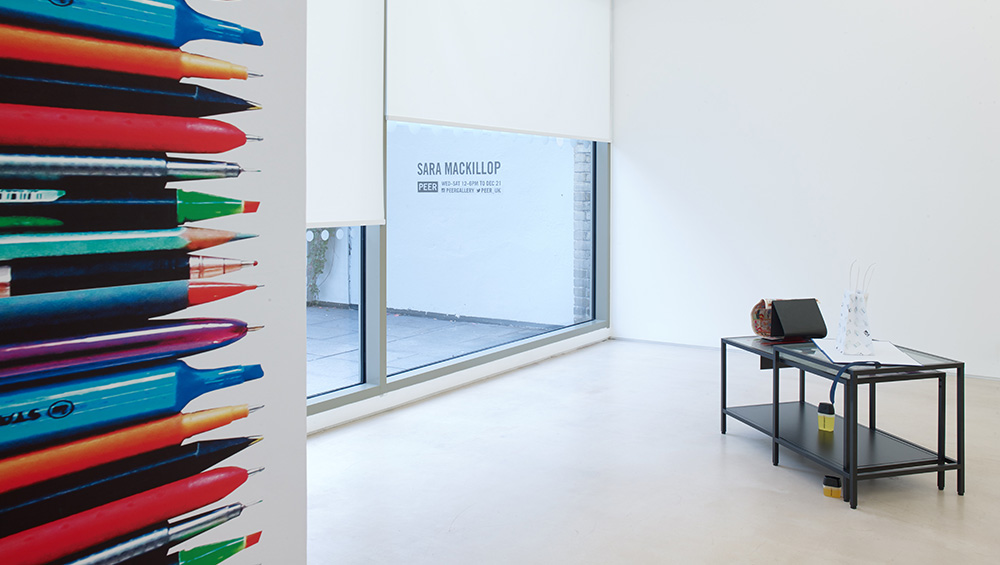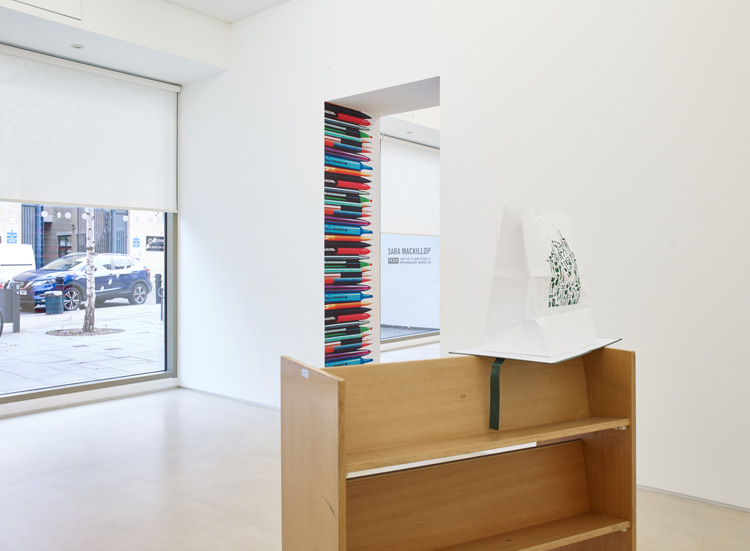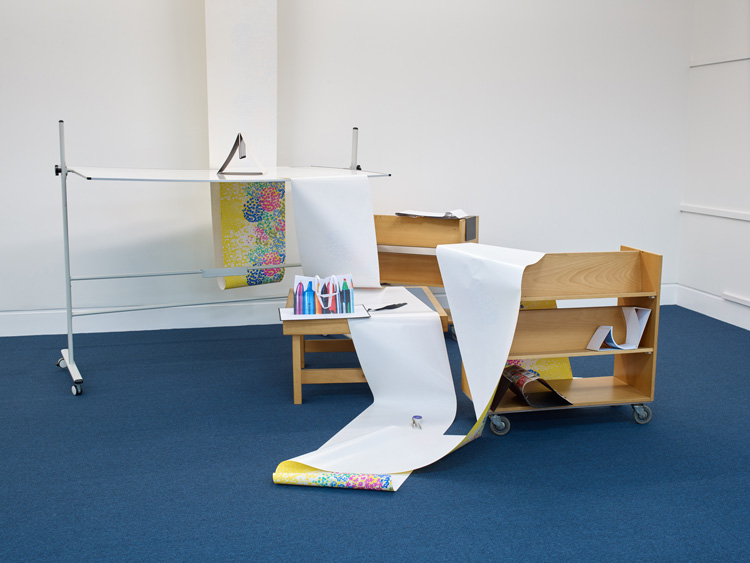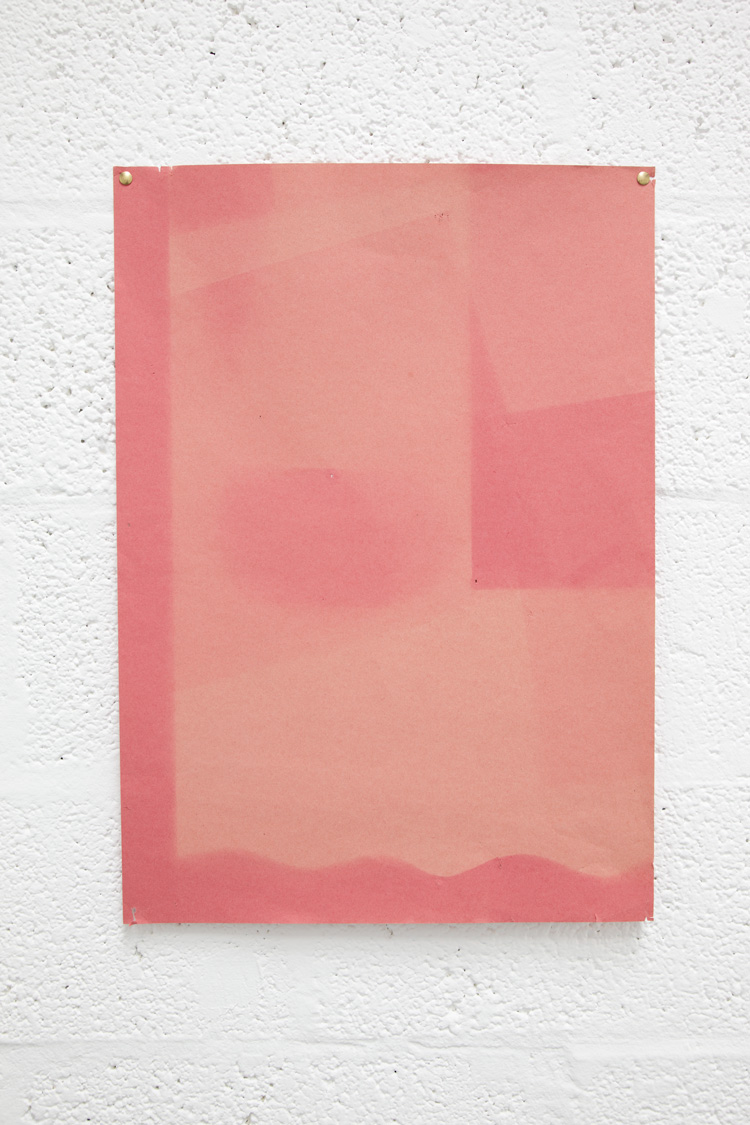
by DAVID TRIGG
In the hands of Sara MacKillop (b1973, Bromley) commonplace objects are reconfigured and recontextualised in unexpected ways. Characterised by a minimalist sensibility, her understated sculptures and installations incorporate stationery products and office ephemera, as well as subtle references to consumerism and the British high street. MacKillop studied fine art at the University of Leeds, where tutors including Griselda Pollock and Terry Atkinson encouraged an interdisciplinary approach to art-making. She continued to discard the distinctions between painting and sculpture at the Royal College of Art, where Matthew Higgs and John Stezaker were among those who encouraged her to pursue the broad path that has informed her distinctive output for more than 20 years.
For her dual-site exhibition Returns and Renewals, MacKillop has installed a selection of new work at Peer’s Hoxton gallery and the adjacent Shoreditch Library, in east London. The show inaugurates the ambitious Peer in the Library programme, a year-long season of exhibitions, events and workshops instigated by the independent arts organisation. Running until September 2020, it sees artists and artist collectives present their work across the two venues with the aim of engaging local communities in contexts beyond the gallery’s white walls.

Sara MacKillop, Returns and Renewals, 2019. Installation view, PEER and Shoreditch Library, Hoxton, London, 2019. Courtesy PEER, copyright Sara MacKillop. Photo: Stephen White.
At Peer, MacKillop has juxtaposed sculptural objects created from commercial readymades and sundry stationery supplies with artists’ books, posters and prints. In the library, a roll of colourful wrapping paper hanging from a balcony leads visitors down into the basement, where a display featuring repatriated library furniture and objects crafted from paper extends the artist’s exploration of the book as a sculptural object. Studio International spoke to MacKillop about the development of the exhibition, her approach to making art inspired by everyday life, and her involvement with artists’ books and self-publishing.
David Trigg: You have said that your works come about through a process of “distracted looking”. Can you elaborate on what you mean by this?
Sara MacKillop: I walk around a lot and, as I’m walking, I might notice something that later becomes the starting point for a work; it is distracted because this is not the main purpose of the activity. I take things that I’ve seen in the world and put them together in different ways. For example, the glass-awareness stickers installed at Peer came about this way.
.jpg)
Sara MacKillop, Returns and Renewals, 2019. Installation view, PEER and Shoreditch Library, Hoxton, London, 2019. Courtesy PEER, copyright Sara MacKillop. Photo: Stephen White.
DT: These are stickers often attached to glass doors and panels, intended to prevent people from walking into them?
SM: Yes. I first noticed them in shop windows, then I suddenly started seeing them everywhere. I began thinking of ways I could use them and disrupt them. It was the same with the window blinds at Peer, which I have chosen to partially close at different heights. As with other galleries I’ve exhibited in, the blinds are usually down during installation and up when the gallery is open. I had noticed at Costa Coffee up the street that the blinds there were all at different heights to keep out the bright sunlight. I became interested in the way that people use blinds and, when spending time at Peer, I noticed people were always staring in through the window.
DT: When I arrived at the gallery, I saw the blinds, but I didn’t really register the small discs on the glass. I didn’t even think about them until I was inside and noticed the way you have covered the windows with these circles, disrupting the pattern with the little yellow bird and snowflake images.
SM: That’s how I wanted it to work: it kind of creeps up on you. There’s also a little fish-eye photo I took looking through the window of Shoreditch Library, the other space the exhibition takes place in up the road.
,-2019.jpg)
Sara MacKillop, Glass Awareness (detail), 2019. © Sara MacKillop.
DT: It’s not always clear how much of your work is made by you and how much is found, or readymade.
SM: I was talking about this with someone at the exhibition opening. I enjoy the blurring of these categories.When I say “found”, as my friend said: “What you really mean is you went up to Ryman and you bought it.”
DT: I was thinking specifically of works such as Carrier Bag Book (Robert Dyas Extension) (2019) and Carrier Bag Book (Maplin) (2019), which appear to be high street shopping bags.
SM: Those were made – I printed them myself. All the logos are adjusted and I like the fact that you don’t know what is found and what is adjusted. The Robert Dyas logo is very interesting because it’s a house made up of different objects. It has been like that for 20 years, but I’ve noticed that now there are many more objects in the house. For my Robert Dyas bag, I used its regular logo, but I’ve drawn an extension on to the house.
,-Digital-print-on-paper,-cotton-tape-and-folder,-50-x-42-x-29.7-cm-unfolded.jpg)
Sara MacKillop, Carrier bag book (Robert Dyas extended), Digital print on paper, cotton tape and folder, 50 x 42 x 29.7 cm unfolded. Installation view, PEER and Shoreditch Library, Hoxton, London, 2019. Courtesy PEER, copyright Sara MacKillop. Photo: Stephen White.
DT: As a comment on the growth of consumerism?
SM: It’s more about playing around with the hierarchies of objects surrounding consumerism and a confusion of what is communicated by different logos and carrier bags. Robert Dyas doesn’t produce a paper gift bag; it’s more of a cheap carrier bag.
DT: And you consider these works to be books?
SM: Yes, they use the form of a book. I was interested in making a book that was actually a container, a different kind of space. The Robert Dyas carrier bag book is an image of a container on a container as a book.
DT: At Peer, you have displayed works on a library trolley; do you consider the trolley a part of the work, or are you merely using it as a plinth?
SM: Essentially, it’s a plinth, but I quite like things to overlap. The works on the trolley could be shown with or without it, but I decided that using the trolley was the best way of displaying them for this exhibition, especially as I have the other installation in Shoreditch Library – it creates a connection between the two spaces.

Sara MacKillop, Returns and Renewals, 2019. Installation view, PEER and Shoreditch Library, Hoxton, London, 2019. Courtesy PEER, copyright Sara MacKillop. Photo: Stephen White.
DY: What draws you to certain objects and materials?
SM: It’s difficult to say. There’s clearly a series of things that I come back to: pens, books and stationery. But other things, like the glass-awareness stickers, which are more architectural, I just came across recently. However, they are often smaller or subsidiary objects. For example, the glass-awareness stickers only work in conjunction with windows; bags and wrapping paper usually surround another object. In 2017, in the show I had at Bonington Gallery in Nottingham, I included a slush machine because they seemed to be everywhere that summer, in every corner shop. I became interested in them as objects, but, to me, the slush was like ink, which connects with the new Pen Holder works I have at Peer. There seems to be something about seeing a thing repeatedly that reinforces it in my mind.
,-2019-Pen-holder-and-fanta-berry-drink,-22cm-x-6.5-x-6.5-cm.jpg)
Sara MacKillop, Pen holder (fanta berry), 2019. Pen holder and fanta berry drink, 22cm x 6.5 x 6.5 cm. Installation view, PEER and Shoreditch Library, Hoxton, London, 2019. Courtesy PEER, copyright Sara MacKillop. Photo: Stephen White.
DT: These new works are commercially available pen holders that you have filled with coloured liquid?
SM: Yes, they’re pen holders designed to look like pens. They’re peculiar things, like totems or something. I bought one and then started finding other ones. I’ve filled them with soft drinks – various flavours of Fanta and Lucozade – which I chose for the colour, to represent ink.
DT: Pens are a recurring theme in your work. At Peer, you are showing another of your pen fences, a repeating pattern based on a photograph of pens that you have stuck to the wall. How did that series begin?
SM: Again, it came from something that already existed. In 2013, the Wilko store in East Ham, London, was announcing a new stationery department and it did this amazing pen fence on vinyl – a line of pens on the front window. I then started noticing them everywhere, in art supplies shops and stationers, in school windows and even in libraries as signage for creative play. In Copenhagen, at Kunsthal Charlottenborg, I covered the perimeter of the gallery with a pen fence; I took six pens from my desk drawer, photographed them and printed the image on billboard posters that ran all the way around the room. The pen fence changes in form each time I show it, for instance on stairs or on windows; each time it’s a different group of pens that I already have lying around.

Sara MacKillop, Pen Fence, 2013. Digital print. Installation view, Kunsthal Charlottenburg, Copenhagen.
DT: There seems to be a dichotomy at play in these pen fences. The fact that the pens do not have lids speaks to potential – the potential for creativity or for communication. But then there is the possibility that they will dry out, so there are also notions of waste and depletion.
SM: The pens don’t have lids because, when I initially saw the motif and then saw it again in other places, such as art shops or libraries, the pens were always depicted without them. But there is certainly a play between communication and the failure to communicate; speaking and not speaking.
DT: Much of your work relies on recontextualising objects, taking things from material culture and reconfiguring them for the gallery. With your installation at Shoreditch Library, many of the objects remain in their original context.
SM: It’s more complicated doing something in a place like that because, despite the fact that I’m a card-holding Hackney Libraries user, it’s not really my space. I went there quite a lot over the period when I was developing the work for the exhibition. The area where I’ve installed my work was always a place where things were put aside that weren’t in day-to-day use. It seemed a good idea to use some of these objects as supports for the things that I’d made or was going to be using in the space. So the whiteboard was always there – I just turned it around to create a flat surface – as well as the small table, and the first time I went there they had all these library trolleys standing around because they were getting rid of them. I also wanted the installation to connect with the work at Peer, which is why I took one of the trolleys into the gallery, so that the library encroaches into Peer, and Peer into the library.
DT: The wrapping paper you have used in the library is very colourful, but you have hung it backwards so only sections of it are visible.
SM: You can see it from outside: it draws you in and down to the basement where my work is installed. It’s a giant roll of wrapping paper designed for gift wrapping in shops. It’s been unwound, rewound on to the reel in reverse, and then wound on to the railing. Again, it’s about muting, but I’m also interested in wrappings, like carrier bags, wrapping paper, things that surround or contain objects.
DT: When I was at the library, the windows were open and there was a breeze coming in, animating the wrapping paper. It speaks to the fact that the library is an uncontrolled environment compared with Peer, where everything is very controlled.
SM: I’m relaxed about that. The work will probably shift over time, people will touch things, the paper might get a bit ripped or something like that, but that’s fine. I once did an exhibition at Spike Island in Bristol where I used faded sugar paper reclaimed from a disused noticeboard. The papers had already been bleached by the sunlight and I just let them continue changing.

Sara MacKillop, Faded Paper, 2011. Found paper. Spike Island,
Bristol. Photo: Stuart Whipps.
DT: I remember being surprised that you chose to exhibit the actual papers. I thought maybe you would want to document them and just show the photographs.
SM: I had these bits of paper for a while and I was talking about it with people and everyone was saying: “These are great, but maybe you need to take photographs.” There was so much conversation about preserving them that it just felt like the thing to do was to let it go. So that became the idea and they did just disappear.
DT: You have an MA in painting from the Royal College, but your work has always been very sculptural. Are these distinctions still relevant?
SM: There are, of course, histories specific to mediums, but I don’t spend a great deal of time thinking about the categories.
DT: But your work Pink Mini Highlighter (2019) nods to painting. It incorporates a canvas.
SM: The canvas in this piece can be viewed as an object as well as a holder of information, a container, and an actual holder for a pen. The canvas is still shrink-wrapped, it still has the label. The work comments on painting in a way – there’s the cut, which has an art-historical precedent with Fontana – but I don’t think it matters if it’s seen as a painting. It can also be seen to comment on art materials as objects.
DT: You are well known for your artist’s books. How did that line of work start?
SM: I was making work using envelopes, where I’d collected all the different security patterns and then scanned them, to compare the differences between them, differences that went beyond bureaucratic need. I tried showing them in different ways, with frames and other things, but it wasn’t working. I then had the idea to try and make a book out of them and I found it to be the perfect form for them. After that, I became interested in the form of the book and having ideas particular to that.
DT: The books you make are all usually multiples, but the carrier bag books in this show are one-offs.
SM: It’s not an edition because I only wanted to make one of each. If you look at my publications all together, they’re not formally or systematically coherent and that was a choice I made at some point. My books are always shifting because the format is part of the book and I’m interested in using these differences.
DT: In 2015, you started the annual Artist Self-Publishers’ Fair (ASP) at the Institute of Contemporary Arts. How did that come about?
SM: Myself and Dan Mitchell, who I run it with, thought there should be a publishing fair that was free for exhibitors. The idea was to have a one-day fair dedicated to artists’ publications. It’s about getting people together for an event; we have someone playing records and it’s just a sociable day. There have been a lot of different people involved in ASP over the years and, so far, it’s all worked out OK and seems to be something people like. This year, we will also be hosting a day of readings and performances.
DT: How do your books relate to your gallery work?
SM: I treat publications in the same way as exhibitions. Sometimes I will be working on something that is definitely for a publication, and sometimes it will be for an exhibition or a piece of work. But, to me, there doesn’t seem to be a separation. They are all equally as important and all a part of my practice.
• Sara MacKillop: Returns and Renewals continues at Peer, London, until 21 December 2019 and at Shoreditch Library (across the road from Peer) until 1 February 2020. The fifth Artist Self-Publishers’ Fair will be held at the ICA, London, on Sunday 8 December 2019.